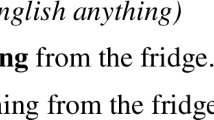Abstract
The idea to use choice functions in the semantic analysis of indefinites has recently gained increasing attention among linguists and logicians. A central linguistic motivation for the revived interest in this logical perspective, which can be traced back to the epsilon calculus of Hilbert & Bernays (1939), is the observation by Reinhart (1992, 1997) that choice functions can account for the problematic scopal behaviour of indefinites and interrogatives. On-going research continues to explore this general thesis, which I henceforth adopt. In this paper I would like to address the matter from two angles. First, given that the semantics of indefinites involves functions, it still does not follow that these have to be choice functions. The common practise is to stipulate this restriction in order to get existential semantics right. However, a so-far open question is whether there is any way to derive choice function interpretation from more general principles of natural language semantics. Another question that has not been formally accounted for yet concerns the relationships between choice functions and the “specificity”/“referentiality” intuition of Fodor & Sag (1982) about indefinites. Is there a sense in which choice functions capture this popular pre-theoretical notion?
I would like to thank Johan van Benthem, Jaap van der Does, Danny Fox, Tanya Reinhart, Eddy Ruys and Henk Verkuyl for discussions.
Access this chapter
Tax calculation will be finalised at checkout
Purchases are for personal use only
Preview
Unable to display preview. Download preview PDF.
Similar content being viewed by others
References
Barwise, J. & Cooper, R. 1981. Generalized Quantifiers and Natural Language. Linguistics and Philosophy 4, 159–219.
van Benthem, J. 1984. Questions about Quantifiers. Journal of Symbolic Logic 49, 443–466.
van der Does, J. 1996. Quantification and Nominal Anaphora. In: K. von Heusinger & U. Egli (eds.). Proceedings of the Konstanz Workshop Reference and Anaphoric Relations. Arbeitspapier 79. Fachgruppe Sprachwissenschaft, Universität Konstanz, 27–56.
van der Does, J. & van Eijck, J. 1996. Basic Quantifier Theory. In: J. van der Does & J. van Eijck (eds.). Quantifiers, Logic and Language. Stanford/CA: CSU Publications, 1–45.
Fodor, J. & Sag, I. 1982. Referential and Quantificational Indefinites. Linguistics and Philosophy 5, 355–398.
Heim, I. 1987. Where Does the Definiteness Restriction Apply? Evidence from the Definiteness of Variables. In: E. Reuland & A. ter Meulen (eds.). The Representation of (In)definiteness. Cambridge/MA: MIT Press, 21–42.
Hilbert, D. & Bernays, P. [1939] 1970. Grundlagen der Mathematik. Vol. II. 2nd ed. Berlin; Heidelberg; New York: Springer.
Keenan, E. 1987. A Semantic Definition of ‘Indefinite NP’. In: E. Reuland & A. ter Meulen (eds.). The Representation of (In)definiteness. Cambridge/MA: MIT Press, 286–317.
Ladusaw, W. 1982. Semantic Constraints on the English Partitive Construction. Proceedings of the First West Coast Conference on Formal Linguistics (WCCFL 1), 231–242.
Milsark, G. 1977. Towards an Explanation of Certain Pecularities in the Existential Construction in English. Linguistic Analysis 3, 1–30.
Reinhart, T. 1992. Wh-in-situ: An Apparent Paradox. In: P. Dekker & M. Stokhof (eds.). Proceedings of the Eighth Amsterdam Colloquium. Institute for Logic, Language and Computation (ILLC), University of Amsterdam, 483-491.
Reinhart, T. 1997. Quantifier Scope: How Labor is Divided Between QR and Choice Functions. Linguistics and Philosophy 20, 335–397.
Ruys, E. 1992. The Scope of Indefinites. Ph.D. dissertation. University of Utrecht.
Sharvy, R. 1980. A More General Theory of Definite Descriptions. The Philosophical Review 89, 607–624.
Thijsse, E. 1983. On some Proposed Universals of Natural Language. In: A. ter Meulen (ed.). Studies in Modeltheoretic Semantics. Dordrecht: Foris, 19–36.
Winter, Y. 1997. Choice Functions and the Scopal Semantics of Indefinites. Linguistics and Philosophy 20, 399–467.
Winter, Y. 1998. Flexible Boolean Semantics: Coordination, Plurality and Scope in Natural Language. Ph.D. dissertation. University of Utrecht.
Editor information
Editors and Affiliations
Rights and permissions
Copyright information
© 2000 Springer Science+Business Media Dordrecht
About this chapter
Cite this chapter
Winter, Y. (2000). What Makes Choice Natural?. In: von Heusinger, K., Egli, U. (eds) Reference and Anaphoric Relations. Studies in Linguistics and Philosophy, vol 72. Springer, Dordrecht. https://doi.org/10.1007/978-94-011-3947-2_12
Download citation
DOI: https://doi.org/10.1007/978-94-011-3947-2_12
Publisher Name: Springer, Dordrecht
Print ISBN: 978-1-4020-0291-5
Online ISBN: 978-94-011-3947-2
eBook Packages: Springer Book Archive



